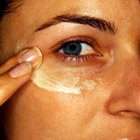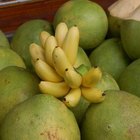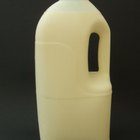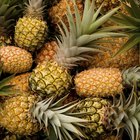
Papayas have properties that can put the annoyances of acne to rest. The plaguing problem arises from an overproduction of oil in the skin; the body naturally produces sebum to keep skin hydrated, but excessive amounts can block cells and trap hair and dead skin cells in pores. Clogged pores become pimples. The enzymes, vitamins and lycopene in papayas help battle blemishes.
Enzymes
Papaya’s enzymes -- papain and chymopapain -- possess antifungal, antibacterial and antiviral properties. Papain is a protein-dissolving enzyme. Skin is composed of proteins; acne-assailant papain breaks down and removes damaged keratin proteins without harming healthy tissue. The exfoliating enzyme unclogs pores by dissolving dry, dead skin cells. It not only purifies pores but also boosts the production of new, healthy cells and acts as an anti-inflammatory agent to keep skin smooth.
Vitamins A, B and C
The vitamins in papayas help blot out blemishes. Antioxidant vitamin A topically treats acne by reducing inflammation and soothing swollen, sore and red spots. It also maintains skin's clarity; vitamin A strips pores of dead skin cells, which can accumulate to cause a breakout. Beta-carotene, a type of vitamin A, promotes healthy skin. Papaya’s dose of vitamins B and C decreases acne-antagonized inflammation and redness, and reduces the skin’s oil production by trapping moisture in the skin.
Lycopene
The fleshy fruit’s richness in color is in part due to its lycopene content. Lycopene in papayas promotes anti-inflammatory and antioxidant activity, which shields the skin from environmental factors that can clog pores and cause breakouts. Papayas also contain skin-lightening properties and can help erase red acne splotches.
Cautions
For the lucky ones, applying the juice of unripe papayas to the skin for 15 minutes and then cleansing with cool water can reduce acne. For the less fortunate, papaya can cause allergic dermatitis or respiratory problems. The milky sap of papaya is laden with latex, which can spark an allergic reaction.
Related Articles

Can Age Spots Be Reversed?

What Are the Ingredients in Proactiv?

List of Retinoids

Avocado Masks for All Skin Types
How to Freeze Papaya

Hair Removal With Papaya

Alternatives to La Mer Creme

Benefits of Shea Butter and Coconut Oil ...

Yogurt, Oatmeal, Honey & Lemon Face Mask

How to Repair Open Pores

Foods From Rainforest Plants

Nutrition Information on Blueberries

How to Remove Dry Skin on the Face

Deep Wrinkle Moisturizing Treatments

Creams for Red Neck Skin

How to Reduce Acne Inflammation

How to Heal an Inflamed Bikini Area

Skin Benefits of Using Peach Kernel Oil

How to Even Out Skin Tone Without Makeup

Homemade Glycolic Acid Peel
References
- Journal of Medicinal Plants and Studies: Traditional and Medicinal Uses of Carica Papaya
- Clearing Concepts: A Guide to Acne Treatment; Mark Lees
- Encyclopedia of Life: Carica Papaya, Papaya
- Natural Acne Clinic: Vitamins to Heal Your Acne
- The Aesthetic Guide: Antioxidant Niacinamide Reduces Acne-Related inflammation
- Linus Pauling Institute at Oregon State University: Vitamin C and Skin Health
- Linus Pauling Institute at Oregon State University: Vitamin C and Skin Health
Resources
Writer Bio
Lexie Delaney, a Chicago native, attended the University of Missouri, where she earned a B.A. in journalism (magazine writing) and a B.A. in Spanish. Delaney began writing and editing more than five years ago, for the "Columbia Missourian," "Vox Magazine" and "Retail Jeweler."
Photo Credits
bennyartist/iStock/Getty Images